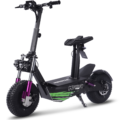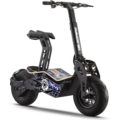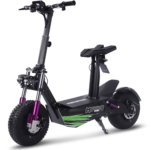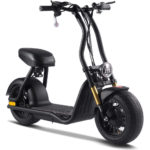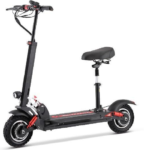- Home
- Scooters
- Electric Scooters
- MotoTec Chaos
MotoTec Chaos
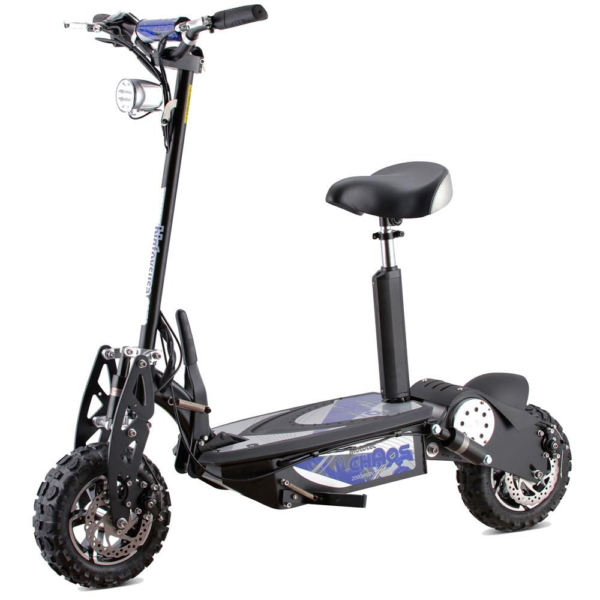

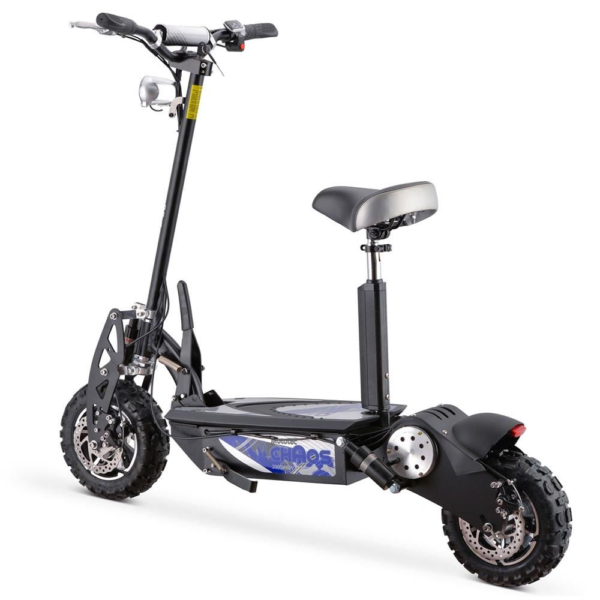
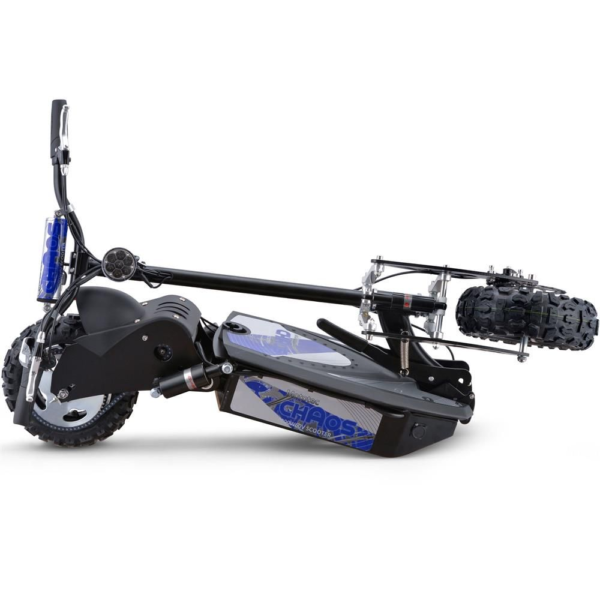
- Battery Range: 15–30 miles (24–48 km)
- Top Speed: 32 mph (51 km/h)
- Motor Power: 2000 W
- Weight Capacity: 265 lb (120.2 kg)
- Charging Time: ~6–8 h
- Scooter Weight: 85.0 lb (38.6 kg)
PROS
- Fast 32 mph performance
- 60 V 15 Ah (900 Wh) lithium pack
- Front + dual rear shocks
- 11″ knobby tires (on/off-road)
- Front & rear disc brakes
- Key ignition and folding lock
CONS
- Heavy to move (85 lb)
- IP rating not published
- No companion app
- Range depends on mode/terrain

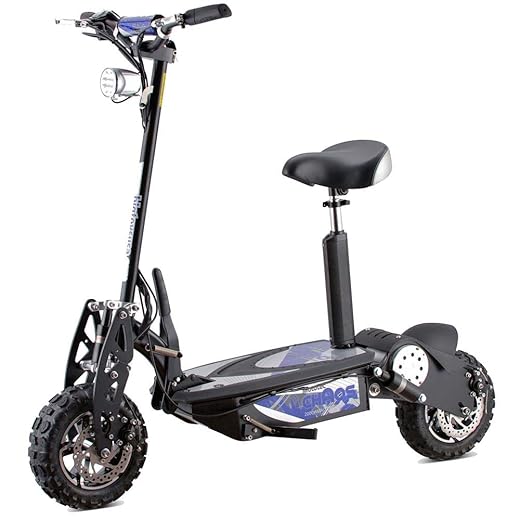
Key Takeaways
- The MotoTec Chaos features a powerful 2000W motor and a robust 60V lithium battery, making it ideal for hills and varied surfaces.
- It offers a foldable frame, wide deck, and easy maintenance, targeting riders who prefer straightforward performance over advanced tech.
- With a top speed of 32 mph and a range of 15 to 30 miles, it suits short to medium commutes and casual rides.
- Its sturdy build with 11-inch knobby tires and effective suspension enhances comfort and stability on uneven terrain.
- The MotoTec Chaos is best for those wanting reliable power without the burden of heavy commuter scooters or complex features.
Table of contents
- What Is the MotoTec Chaos?
- How the MotoTec Chaos Works
- Key Specifications
- Design & Build Quality
- Performance Fundamentals
- Battery, Range & Efficiency
- Ride Quality & Comfort
- Braking & Safety Features
- Portability & Daily Usability
- Maintenance & Care
- Weather & Seasonal Considerations
- MotoTec Chaos vs Alternatives
- Who the MotoTec Chaos Is (and Isn’t) For
- FAQs
- Glossary
- Final Notes on Setup and Use
- Why the MotoTec Chaos Still Stands Out
The MotoTec Chaos is a punchy stand-up scooter for rough pavement and light trails. It pairs a 2000-watt brushless motor with a 60-volt lithium pack, so it climbs hard and holds speed on flats. It rolls on big 11-inch pneumatic knobby tires that bite into loose stuff and still feel calm on clean streets. If you want simple hardware, strong pull, and a rugged vibe, this fits.
What Is the MotoTec Chaos?
The MotoTec Chaos is a chain-drive electric scooter with a foldable frame and a quick-release seat. It runs a 60V, 15Ah lithium-ion battery and a 2000W motor, so it sits near the top of MotoTec’s old-school power lineup. The cockpit keeps things basic: a keyed ignition, a twist throttle, an economy switch, and two brake levers for the front and rear discs. The deck is wide and covered with ABS, so it shrugs off scuffs.
This model suits riders who want proven parts and easy service. It is not light. It is not a long-range machine. Think of it as a compact power scooter that trades shiny screens and apps for straightforward speed and strong hill starts. If you like a calmer, city-first setup, the MotoTec Metro fits that brief and keeps things simple.
How the MotoTec Chaos Works
The Chaos follows a simple path from battery to wheel, and each piece does one clear job.
Motor and controller. A 2000-watt brushless motor drives the rear wheel through a chain. The controller meters current from the battery and shapes the torque curve. An economy toggle lowers demand, so you stretch range on calm routes.
Battery. The pack is 60V, 15Ah (about 900Wh). So it hits hard off the line and holds pace on grades. It sits low in the frame, then stays protected from spray.
Throttle. A twist grip sends position to the controller. The controller ramps current to the motor. The roll feels natural if you come from bikes or small motorcycles, and it gives fine control at walking speed.
Brakes. Front and rear cable-actuated discs do the stopping. You get two levers, one per wheel, and the setup makes pad swaps and cable tweaks easy at home. So upkeep stays cheap.
Suspension. A single front shock and dual rear shocks take the sting out of potholes and curb cuts. They keep rubber on the ground, then help the scooter track straight when you brake hard.
Key Specifications
Here are the core factory details with both imperial and metric units. These specifications are the official data points riders ask about first.
| Block | Item | Value |
|---|---|---|
| General | Model | MotoTec Chaos |
| Drive System | Chain | |
| Frame | Foldable locking frame (Posi-Lock) | |
| Seat | Quick-release seat included | |
| Deck | ABS cover, wide standing area | |
| Performance & Power | Motor | 2000W brushless, rear drive (chain) |
| Top Speed | 32 mph (≈ 51.5 km/h), rider/terrain dependent | |
| Hill Use | Strong torque for short, steep climbs | |
| Battery, Charging & Electrical | Battery | 60V 15Ah lithium-ion (≈ 900 Wh) |
| Charging Time | 6–8 hours (charger included) | |
| Battery Life | ≈ 250 cycles (typical) | |
| Economy Mode | Yes (reduces demand to extend range) | |
| Ignition | Keyed | |
| Lighting | Headlight (front) | |
| Build & Dimensions | Tires | 11-inch pneumatic knobby (front and rear) |
| Suspension | Single front shock, dual rear shocks | |
| Product Size | 47 × 26 × 42 in (L×W×H) — 119.4 × 66.0 × 106.7 cm | |
| Folded Dimensions | 46 × 25 × 21 in — 116.8 × 63.5 × 53.3 cm | |
| Product Weight | 85 lb — ≈ 38.6 kg | |
| Max Load | 265 lb — ≈ 120 kg | |
| Carton (ship) | 47 × 13 × 19 in, 88 lb — 119.4 × 33.0 × 48.3 cm, ≈ 39.9 kg | |
| Safety & Control | Brakes | Front and rear disc (mechanical) |
| Controls | Twist throttle, dual brake levers, economy switch | |
| Features & Extras | Folding | Yes (Posi-Lock) |
| Cruise Control | Not listed | |
| Other | Rear-wheel service parts available | |
| Warranty & Compliance | Warranty | 60 days, parts replacement |
| Water Rating | Not stated |
Design & Build Quality
The MotoTec Chaos leans into sturdy parts and no-nonsense service. The metal frame carries the battery and motor without obvious flex at city speed. The ABS deck cover wipes clean fast, so you spend less time scrubbing. The hinge uses a positive latch, and the joint stays tight if you lock it fully. The quick-release seat clicks in and out in seconds, then lets you switch from seated to stand-up without tools.
The cockpit keeps your hands busy only when needed. You get a keyed ignition, a right-hand twist throttle, and a simple toggle for economy mode. Two brake levers manage the discs. The grips feel tacky even with damp fingers, and the setup reads like a small motorbike. Switches click with a clear stop. The throttle rolls smooth with a distinct point where power wakes up.
Rolling gear is just as direct. The 11-inch knobby tires have a round profile for predictable turn-in and a big air volume for some cushion. A single front shock and twin rear shocks take down the hit from patched asphalt. The stance is wide, so the scooter tracks straight through alley grit and park paths. The chain drive also helps, since sprockets and chains are easy to replace with common tools.
Fit and finish land in the “workhorse” lane. Paint coverage looks even, hardware sits square, and cable runs stay tidy and reachable. You won’t find a fancy display here. You will find parts that take a beating and keep moving with basic care.
Performance Fundamentals
The first thing you feel is torque. The 2000W motor pulls cleanly from a stop and builds speed in a steady arc. The scooter keeps pushing up to typical city limits, so it clears gaps in traffic without drama. On a long straight, the steering stays calm, and the deck gives you room to shift your stance as speed rises.
Hill work is a strong point. On grades around 7–10%, the Chaos holds pace better than mid-power commuters. It doesn’t bog when you throw on a backpack or a small grocery haul. So short climbs feel easy. If you ride near the 265-lb (≈ 120-kg) max load, pick a lower cruise and let the motor pull smoothly to keep heat in check.
Cruising feels settled on mixed pavement. The big tires roll over seams and brick patches without harsh kickback. The stem stays steady unless you hammer through deep ruts at speed. A bit of front dive under hard braking helps keep the rear planted. The fork rebounds without a bounce, then returns to center cleanly.
Battery, Range & Efficiency
The pack is 60V, 15Ah, or roughly 900 watt-hours. The stated range lands between 15 and 30 miles (24 to 48 km). That spread makes sense once you factor in throttle habits and economy mode.
Real-world range shifts with a few key inputs:
- Rider weight. Heavier riders draw more current, so range drops.
- Terrain. Hills and grass raise demand. Flat routes stretch miles.
- Temperature. Lithium cells prefer mild weather, so cold days cut range.
- Tire pressure. Soft tires add rolling drag and heat.
- Economy mode. Lower demand adds a few miles on calm routes.
Here’s a quick mental model. A rider around 180 lb (≈ 82 kg) on mixed pavement with light hills, using economy mode when cruising, may see mid-20s miles (≈ 40 km). A heavier rider who climbs hard and rides fast will land near 15 miles (≈ 24 km).
Charging from low takes about 6 to 8 hours. So an overnight top-up slots into most routines. Short partial charges work fine when you only need a quick errand. For battery health, store the scooter in a cool, dry place, avoid leaving it empty, and leave the pack around the middle if it will sit for weeks.
Ride Quality & Comfort
The Chaos feels planted and easy to read. The wide deck supports a diagonal stance, and you can move your front foot as you shift from slow turns to faster travel. The bar height fits most adults, so your elbows keep a soft bend. The twist throttle is smooth enough for slow maneuvers through crowds. You can creep along a parking row without choppy inputs.
The suspension surprises for this price tier. The front fork eats curb cuts taken at shallow angles. The twin rear shocks trim the sharp bite from expansion joints. You still feel the road, which is good feedback, but the chatter doesn’t wear you down on longer rides.
Tires play a big role. The 11-inch knobbies offer big air volume and a tread that grips dirt paths and broken shoulders. They remain calm on clean pavement if you hold pressure within the sidewall range. Traction stays predictable in dry and lightly wet conditions. The large diameter also helps the scooter roll out of small holes that would stall smaller wheels.
Stem flex is low for the class. You might feel a touch if you smack a pothole at speed. The hinge stays quiet if you keep the latch snug and clean. The riding posture stays steady when you brake hard or lean through a long sweeper.
Braking & Safety Features
You get dual mechanical disc brakes. The levers take up lightly, then bite about halfway into the pull, and build to a firm stop. Splitting braking between front and rear keeps the scooter straight and shortens stop distance for this tire size when pads and rotors are fresh.
A headlight helps at dawn and dusk, and it makes you easier to spot. Reflectors on the frame and wheels add side visibility. For night runs, add a bright rear light on the seatpost or your backpack. Keep the headlight lens clean and aimed level with the road.
A water rating is not published. Ride with care in rain, slow down for paint stripes, and avoid puddles that hide holes. Big tires help a bit, yet traction still falls as tread fills with water and grit. Your rotors may need a short scrub before they reach full bite again.
Portability & Daily Usability
This scooter is not light. At about 85 lb (≈ 38.6 kg), carrying it up flights of stairs is a workout. The fold helps with trunks and storage rooms, though. The folded size—46 × 25 × 21 in (116.8 × 63.5 × 53.3 cm)—fits many hatchbacks and closets. If you use trains, plan to roll station-to-station rather than shoulder it.
The latch feels secure once closed. Double-check it after folding and unfolding to keep the stem tight. The quick-release seat helps on long rides or cargo runs. Pop it off when you want clean stand-up control in tighter spots.
For parking, use a sturdy U-lock through the frame when you can. A thick chain around a fixed point is the next best option. Always remove the key and switch the scooter off. The keyed ignition deters casual tampering, so it adds a simple extra layer.
Maintenance & Care
A small routine keeps the Chaos running well. The parts are common and easy to reach, so home care is realistic.
Before each ride
- Check tire pressure against the sidewall range.
- Spin both wheels and look for rotor rub.
- Check chain tension and add lube if it feels dry, then wipe the excess.
Weekly
- Wipe the frame and deck to spot loose bolts.
- Squeeze each brake lever and confirm smooth return.
- Check the hinge latch for play and tighten if needed.
Monthly
- Measure chain slack with the rear wheel off the ground. Adjust at the axle slots to match the manual.
- Inspect pads and swap them when the friction layer looks thin.
- Clean the headlight lens and confirm cable runs aren’t rubbing a tire.
Battery habits
- Store at room temperature when possible.
- Don’t leave the pack at zero. Charge after rides or by day’s end.
- For a break longer than two weeks, leave the battery around mid-charge, then top it off before you ride.
These steps are quick, and they catch little issues early. That saves you time later.
Weather & Seasonal Considerations
Heat, cold, and rain all change how a scooter feels, and the Chaos follows the same rules.
Rain. Water lifts fine dust into a slick film. Slow your corner entry and brake earlier. Knobby tread helps at mild lean angles. Dual discs keep power, but the first squeeze may feel light until rotors dry.
Cold. Lithium packs deliver less energy in low temps. Expect less range. Warm the pack indoors before a winter ride when you can. Check tire pressure, since cold air drops it overnight.
Heat. On hot days, let the scooter rest after long climbs. Avoid sealing it in a trunk under direct sun. High internal temps shorten battery life. Give the pack airflow while charging, and lube the chain a bit more often.
Storage. Dry spaces win. Keep the scooter off wet grass and out of standing water. Wipe the chain and rotors after wet rides to prevent rust. Check the hinge and axle nuts before your next outing.
MotoTec Chaos vs Alternatives
The MotoTec Chaos straddles commuter and performance classes. It has more punch than entry commuters with 36–48V packs. It usually weighs less and costs less than the big-battery, hydraulic-brake rigs. So it fits riders who want torque and trail-ready tires without going all the way to heavyweight machines.
Where the Chaos shines
- Short to medium rides with hills.
- Mixed surfaces: broken pavement, alley grit, park paths.
- Simple DIY service: chains, cables, pads, and sprockets.
- Riders who prefer twist throttles and keyed ignition.
Where a commuter might win
- You carry your scooter up stairs every day.
- You want app features and a color display.
- You need a folder under 40 lb (≈ 18 kg).
Where a bigger performance rig might win
- You want hydraulic brakes and long mountain descents.
- You chase 40+ mph and 30+ Ah packs.
- You ride long distances on trails every weekend.
So the Chaos makes sense for power-leaning city riders who still want a practical size. It covers rough routes better than slim commuters, and it stops short of the bulk of race-style machines. If you want a livelier, dirt-friendly feel, the MotoTec Free Ride points that way.
Who the MotoTec Chaos Is (and Isn’t) For
Great for
- Suburban commutes with a few hills.
- Students who ride mixed campus paths.
- Last-mile runs from a driveway to a bus stop or park-and-ride.
- Adults who want simple parts and easy maintenance over screens and apps.
Not ideal for
- Anyone who must carry a scooter up several floors.
- Long-range riders who want 40+ miles (≈ 64+ km) per charge.
- Daily wet-weather riders who need a published water rating and sealed connectors.
If you want real power, tough tires, and low-stress upkeep, the MotoTec Chaos covers it. It still folds, and it still fits a trunk.
FAQs
1) How fast is the MotoTec Chaos?
The stated top speed is up to 32 mph (≈ 51.5 km/h). The exact number depends on rider weight, wind, and terrain.
2) What is the real-world range?
Most riders see 15 to 30 miles (≈ 24 to 48 km) per charge. Plan for the low end if you’re heavy, face hills, or ride fast.
3) Does it have cruise control?
No cruise control is listed. The economy toggle is the only ride-mode feature.
4) What brakes does it use?
Front and rear mechanical disc brakes with cable actuation. Pad swaps and adjustments are straightforward.
5) Can I ride the Chaos in the rain?
A water rating isn’t stated. Ride with care in wet conditions and avoid deep puddles.
6) How does this compare to a commuter scooter?
It’s more powerful, heavier, and better on rough surfaces. It lacks the light weight and app features many commuters offer.
7) What routine maintenance should I expect?
Chain tension checks, pad inspections, tire pressure checks, and hinge latch checks. Wipe-downs after wet rides help, too.
Glossary
Ah (amp-hours). Battery capacity. More Ah means more stored charge.
Wh (watt-hours). Battery energy (volts × amp-hours). Bigger number, longer potential range.
Controller. The box that meters current from the battery to the motor.
Brushless motor. An electric motor with electronic commutation for low wear.
Chain drive. Power to the rear wheel using sprockets and a chain.
Twist throttle. A grip you rotate to control power.
Economy mode. A setting that reduces current draw to extend range.
Disc brake. A caliper squeezes pads on a rotor to slow the wheel.
Pneumatic tire. Air-filled tire that adds cushion and grip.
Knobby tread. Blocky lugs that bite into dirt and loose gravel.
Stem flex. Small bending of the steering column under load.
IP rating. Code that describes dust and water resistance.
Rotor. The metal disc clamped by the brake caliper.
Caliper. The brake part that holds the pads and squeezes the rotor.
Regen. Light energy recovery when the motor resists rotation; not listed here.
Watt-hours per mile. A rough efficiency gauge; lower is better.
Final Notes on Setup and Use
Set tire pressures within the sidewall range before the first ride. Check the hinge latch for a full lock each time you unfold. Take a short loop near home to bed pads and confirm straight tracking. You’ll catch cable stretch early and dial a small tweak if needed.
Stand balanced. Point your front foot slightly forward, set your rear foot wide across the deck, and keep a soft bend in your elbows. Look far down the lane. These basics smooth out inputs and shorten reaction time.
Carry a tiny tool roll: hex keys, a small adjustable wrench, a cable cutter, chain lube, and a rag. Keep spare pads at home. You’ll be ready for normal wear and keep the scooter tight and quiet.
Why the MotoTec Chaos Still Stands Out
Plenty of scooters chase big range with massive packs. The MotoTec Chaos takes a different path. It delivers stout torque, serviceable parts, and a tough stance. It brings 11-inch tires and real suspension to a package that still folds and fits a car trunk. If you prefer power and simple upkeep over flash, this one just works.
Specifications
General
| Model The Model specifies the exact version or name of the scooter. It helps identify its unique design, features, and specifications within the manufacturer’s product line. Knowing the model makes it easier to compare options, find compatible accessories, or look up support information. | Chaos |
| Brand The Brand identifies the manufacturer or company that designs and produces the scooter. A trusted brand is a sign of quality, reliability, and good customer support. Well-known brands often have higher standards for safety, performance, and after-sales service, giving you more confidence in your purchase. | MotoTec |
| Release Date The Release Date indicates when the scooter model was officially launched on the market. This helps you know how current the design, technology, and features are. A newer release date often means updated components, improved performance, and the latest safety or smart features. | 18 November 2025 |
| Recommended Age Recommended Age indicates the minimum age range that the scooter is designed for, based on safety, size, and ease of use. Following the recommended age helps ensure that riders can handle the scooter’s speed, weight, and controls comfortably and safely. Always check local laws and use protective gear, especially for younger riders. | 13+ |
Performance & Power
| Motor Power (Wattage) What it means: The motor power, measured in watts (W), shows how strong the scooter’s electric motor is. Why it matters: Higher wattage usually means better acceleration, more torque, and improved performance on hills or rough terrain. For example, a 250W motor is good for flat city roads and light riders, while a 500W or 1000W motor provides more power for faster speeds or climbing steep inclines. | 60 V 2000 W chain drive (brushless) |
| Top Speed The Top Speed indicates the maximum speed that the scooter can reach under optimal conditions. It’s usually measured on level ground with a fully charged battery and an average rider weight. A higher top speed allows you to travel longer distances faster, but always ensure you ride within legal speed limits and your personal comfort zone for safety. | 32 mph (51 km/h) |
| Battery Capacity Battery Capacity refers to the total amount of energy the scooter’s battery can store, usually measured in ampere-hours (Ah) or watt-hours (Wh). A higher battery capacity means you can ride longer distances on a single charge, reducing the need for frequent recharging. Keep in mind that actual range can vary depending on rider weight, terrain, speed, and weather conditions. | 60 V 15 Ah (900 Wh) |
| Estimated Range per Charge The Estimated Range per Charge indicates the average distance the scooter can travel on a single full battery charge. This range is calculated under optimal conditions, such as flat terrain, moderate speed, and average rider weight. Real-world range may vary depending on riding style, terrain, weather, and load. A longer range means fewer recharges and greater freedom for longer trips. | 15–30 miles (24–48 km) |
| Hill Climb Ability Hill Climb Ability describes the maximum incline or slope that the scooter can handle while maintaining stable performance. It’s typically expressed as a percentage or in degrees. A higher hill climb rating means the scooter can tackle steeper hills without losing too much speed or power. Actual climbing performance may vary based on rider weight, battery charge, and terrain conditions. | Not specified |
| Drive System The Drive System refers to how power from the motor is delivered to the wheels. Electric scooters typically use either a hub motor (directly integrated into the wheel) or a chain/belt drive system. A high-quality drive system ensures smooth acceleration, efficient power transfer, and low maintenance. The choice of drive system affects performance, noise level, and overall ride experience. | Chain drive (RWD) |
Charging & Electrical
| Charging Time Charging Time indicates how long it takes to fully recharge the scooter’s battery from empty to 100% using the standard charger provided. Faster charging means less downtime and more time on the road. Actual charging time may vary slightly depending on battery capacity, charger output, and environmental conditions. | Approx. 6–8 hours |
| Battery Type Battery Type refers to the specific technology used in the scooter’s battery, which affects performance, lifespan, weight, and charging time. Most modern electric scooters use high-quality lithium-ion (Li-ion) batteries because they offer a good balance of energy density, durability, and low maintenance. A reliable battery type ensures consistent power delivery and longer riding ranges. | Lithium-ion pack |
| Removable Battery A Removable Battery means the battery pack can be easily detached from the scooter for convenient charging and replacement. This feature allows you to charge the battery separately, swap it with a spare for extended range, or securely store it indoors in extreme weather. Removable batteries add flexibility and make it easier to keep your scooter powered up wherever you are. | Non-removable internal battery (fixed pack) |
| Regenerative Braking Regenerative Braking is an energy-saving feature that converts some of the energy normally lost during braking back into battery power. When you slow down or brake, the motor works in reverse to generate electricity, which helps extend the scooter’s range and improves overall efficiency. This system also reduces wear on traditional brake components, leading to lower maintenance over time. | No |
| Lighting Lighting refers to the built-in front and rear lights that enhance visibility and safety when riding in low-light conditions or at night. Good lighting helps you see the road ahead and ensures that other road users can see you. Many scooters include LED headlights, taillights, and sometimes brake lights or side reflectors for added safety and compliance with local traffic regulations. | Headlight (rear/brake light not specified) |
Build & Dimensions
| Scooter Weight Scooter Weight refers to the total weight of the scooter when fully assembled, including the battery. This affects how easy it is to carry, lift, and store the scooter when not in use. A lighter scooter is more portable and convenient for commuting, especially if you need to carry it upstairs or onto public transport. Keep in mind that a sturdy frame and quality components may add to the weight but also contribute to better durability and ride stability. | 85.0 lb (38.6 kg) |
| Maximum Rider Weight Maximum Rider Weight indicates the highest rider weight that the scooter is designed to safely support while maintaining optimal performance and stability. Staying within this limit helps ensure reliable acceleration, braking, and climbing ability, and it protects the frame, suspension, and motor from excessive strain. Exceeding the recommended limit may reduce performance and increase wear on components. | 265 lb (120.2 kg) |
| Deck Size Deck Size refers to the dimensions of the scooter’s standing platform. A wider and longer deck provides more foot space, allowing you to stand comfortably and adjust your stance while riding. A well-sized deck improves balance and stability, especially on longer rides or at higher speeds. Compact decks, on the other hand, help keep the scooter lightweight and portable. | ABS deck; seat with quick release; foldable locking frame |
| Handlebar Height Handlebar Height refers to the distance from the deck to the handlebars, which affects your riding posture and comfort. An appropriate handlebar height helps you maintain good balance, reduces strain on your back and arms, and makes steering more comfortable. Some scooters have adjustable handlebars to fit riders of different heights, while others have a fixed height for a streamlined design. | Fixed |
| Folding Mechanism The Folding Mechanism describes how easily and securely the scooter can be folded for carrying and storage. A well-designed folding system lets you quickly collapse the scooter into a compact size, making it convenient to transport on public transit, store under a desk, or fit into a car trunk. Look for sturdy latches and safety locks to ensure the scooter stays firmly in place when folded or unfolded. | Posi-Lock folding |
| Dimensions Folded Dimensions indicate the size of the scooter when it’s fully folded. This measurement shows how much space the scooter will take up when stored or carried, making it easier to check if it will fit in your car trunk, under a desk, or in a closet. Compact folded dimensions are ideal for commuters who need to bring their scooter on public transport or store it in tight spaces. | Unfolded: 47 × 26 × 42 in; Folded: 46 × 25 × 21 in |
| Material Material refers to the primary construction materials used for the scooter’s frame and key components. High-quality materials like aircraft-grade aluminum, reinforced steel, or durable composites provide strength, stability, and a lighter overall weight. A sturdy material ensures the scooter can handle daily wear and tear while maintaining safety and performance. | Steel frame; ABS deck |
Safety & Control
| Brake Type(s) Brake Type(s) describe the braking systems the scooter uses to help you slow down or stop safely. Common brake types include mechanical brakes (like drum or disc brakes), electronic brakes, and foot brakes. Many scooters combine multiple braking systems for added safety and shorter stopping distances. The type and quality of brakes affect your control, especially when riding at higher speeds or on slopes. | Front & rear disc |
| Suspension Suspension refers to the system that absorbs shocks and vibrations while riding, providing a smoother and more comfortable ride over uneven or rough surfaces. Scooters may have front suspension, rear suspension, or dual suspension for better shock absorption and stability. Good suspension helps reduce rider fatigue and improves control, especially when riding on bumpy roads or off-road paths. | Front single + dual rear suspension |
| Tire Type Tire Type refers to the kind of tires the scooter uses, which directly affects ride comfort, traction, and maintenance. Common types include solid (airless) tires, pneumatic (air-filled) tires, or hybrid options. Pneumatic tires offer better shock absorption and a smoother ride on rough surfaces, while solid tires are puncture-proof and require less upkeep. The right tire type helps ensure safe handling and a comfortable ride in different conditions. | 11″ pneumatic knobby tires |
| Tire Size Tire Size indicates the diameter and width of the scooter’s tires, which affect ride comfort, stability, and how well the scooter handles different terrains. Larger tires generally offer better shock absorption and a smoother ride over bumps and rough surfaces, while smaller tires keep the scooter lighter and more portable. Choosing the right tire size helps ensure a balance between agility and comfort. | 11-inch |
| Kickstand The Kickstand is a built-in stand that allows you to park your scooter upright when it’s not in use. A sturdy kickstand keeps the scooter stable and prevents it from tipping over, protecting it from scratches and damage. It also makes storing and accessing your scooter more convenient, whether you’re at home, work, or on the go. | Not specified |
| Water Resistance Rating Water Resistance Rating indicates how well the scooter is protected against water and moisture, usually shown as an IP (Ingress Protection) rating. This rating helps you understand whether the scooter can handle light rain, splashes, or wet roads without damage. While most scooters are not fully waterproof, a good water resistance rating adds peace of mind when riding in changing weather conditions. Always avoid deep puddles or submerging the scooter to protect its electrical components. | Not specified |
Features & Extras
| Display/Console The Display (or Console) shows important real-time information about your ride, helping you monitor your scooter’s status at a glance. Typical displays show speed, battery level, distance traveled, and riding mode. Some models also include additional features like Bluetooth connectivity, app integration, or backlighting for better visibility at night. A clear and easy-to-read display enhances safety and convenience on every trip. | Not specified |
| Ride Modes Ride Modes refer to the different speed and power settings you can choose to match your riding style or road conditions. Common modes include eco for maximum range and energy efficiency, standard for everyday balance, and sport or turbo for higher speed and stronger acceleration. Switching between ride modes allows you to customize performance, conserve battery, and ride safely in various environments. | Economy/Normal (eco button) |
| Smart App Connectivity Smart App Connectivity lets you pair your scooter with a dedicated mobile app via Bluetooth. Using the app, you can monitor real-time ride stats like speed, battery level, and range, adjust settings such as ride modes or cruise control, lock the scooter for added security, and sometimes receive firmware updates. This feature adds convenience and allows you to personalize your riding experience right from your smartphone. | No companion app |
| Anti-Theft System The Anti-Theft System helps protect your scooter from unauthorized use or theft. This feature can include built-in alarms, electronic motor locks, GPS tracking, or remote locking through a mobile app. A good anti-theft system provides peace of mind when parking your scooter in public spaces, adding an extra layer of security to safeguard your investment. | Key ignition |
| Cruise Control Cruise Control allows you to maintain a steady speed without continuously holding the throttle. This feature makes longer rides more comfortable by reducing hand fatigue and providing a smoother, more relaxed riding experience — especially on flat, open roads or bike lanes. For safety, cruise control can usually be easily activated or deactivated while riding. | No |
| Accessories Included Accessories Included lists the additional items that come with the scooter to enhance your riding experience and convenience. Common accessories may include a charger, kickstand, bell, lights, phone holder, or carrying strap. These extras add value by making your scooter safer, easier to use, and ready to ride straight out of the box. | Scooter, charger, quick-release seat, tools, manual |
Warranty & Compliance
| Warranty Period The Warranty Period indicates how long the manufacturer guarantees the scooter against defects in materials and workmanship under normal use. A good warranty provides peace of mind, showing the brand’s confidence in its product quality. Always check what parts are covered, such as the frame, battery, and motor, and follow the maintenance guidelines to keep your warranty valid. | 60 days parts replacement |
| Certifications Certifications confirm that the scooter meets specific safety, quality, and environmental standards set by recognized organizations or regulatory bodies. Common certifications may include CE, RoHS, UL, or other local compliance marks, depending on your region. These certifications ensure that the scooter is manufactured to high standards and is safe and legal to use in your country. | Region-dependent |
Price Comparison





